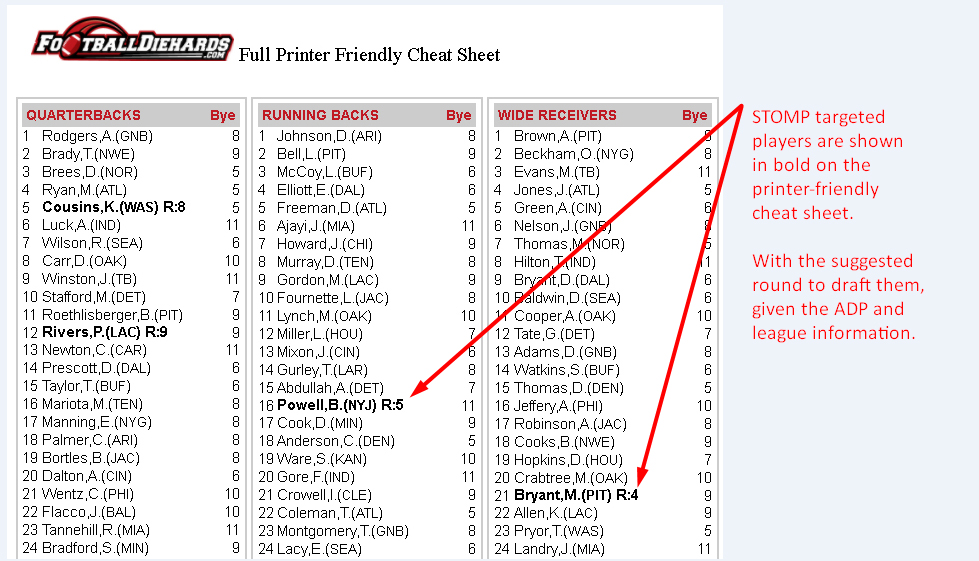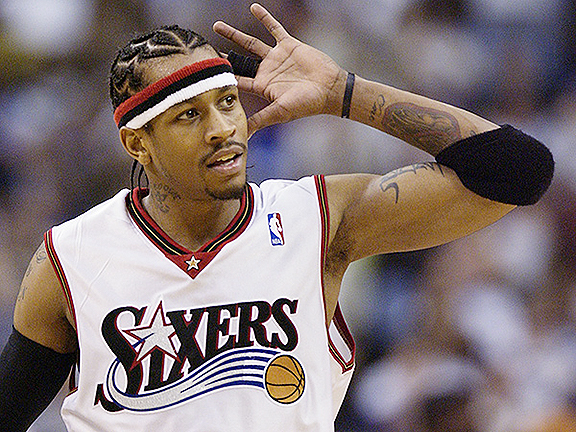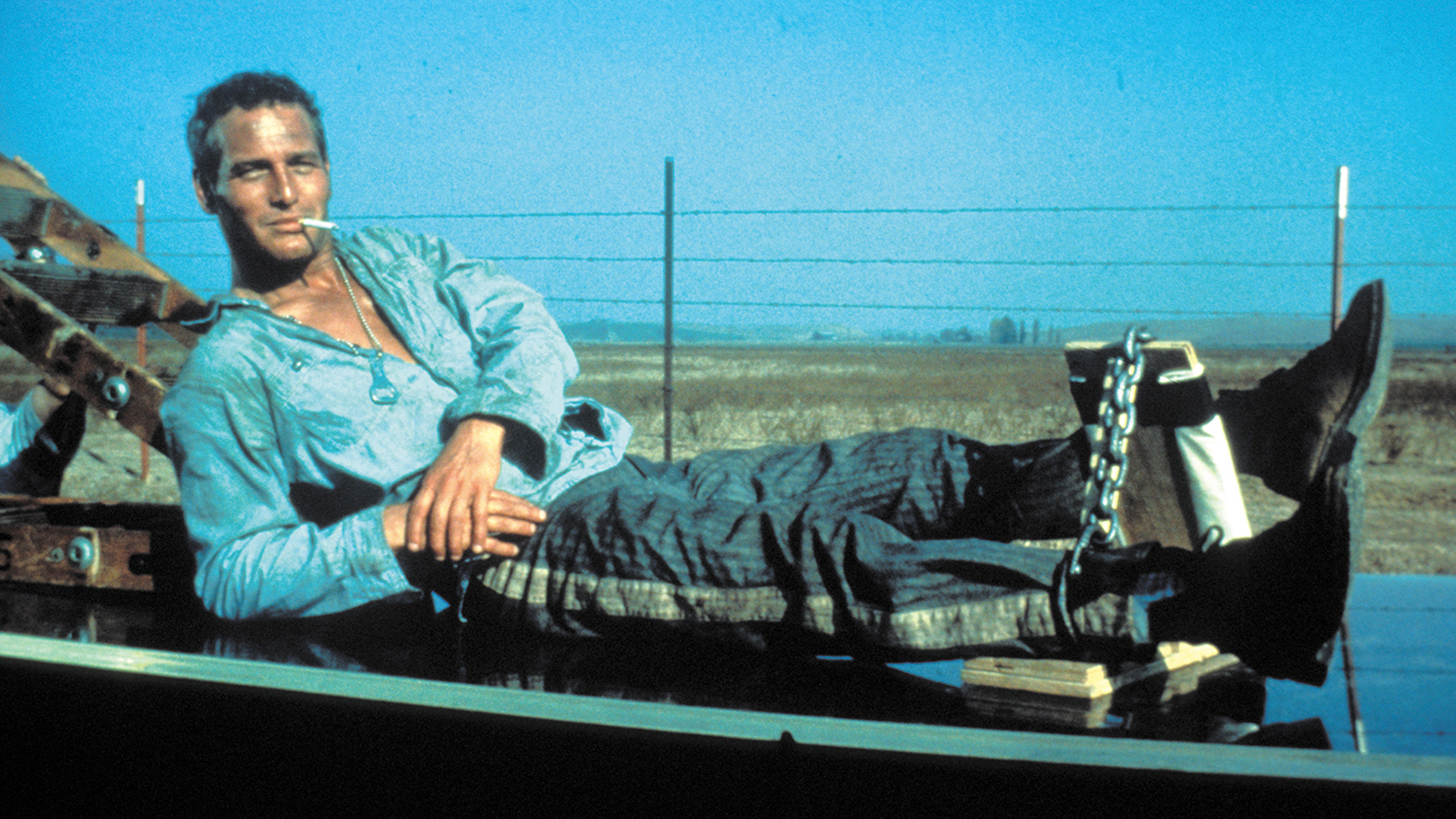Draft Strategies | Depth Charts | Mock Drafts | SOS | Tools | ADP
Diehards Staff Experts Poll | Draft Simulator | University Videos
STOMP Fantasy Football Draft Theory - Strategies

STOMP Draft Theory (Strategic Targeting Of ADP Mapping)
Click here for: STOMP Draft Tool

(Keep your eyes open at all times during your draft!)
Fantasy football managers are always looking for new and innovative ways to help them prepare for and execute well during their drafts. Many different methodologies have been created over the decades along with countless web-based tools and/or mobile apps that aid in real time as your drafts progress.
We at Football Diehards obviously have those kinds of tools -- including our Diehard Drafter Tool (DDT). We also use value-based drafting in our online cheat sheets and configurable cheat sheet to help those who use that methodology.
A relatively new method (although one we’ve been developing for a few years) is called STOMP.
STOMP is an acronym for Strategic Targeting Of ADP Mapping.
This method has been constructed to take advantage of average draft position (ADP), a tool that can be very useful in drafting. What STOMP does is help you put together a simple map of key targeted players that can be loaded into an Excel spreadsheet and is also integrated into our online, configurable cheat sheets.
The STOMP map basically takes your league information and the players you want to target and lays down which rounds you need to draft each player. Sounds pretty basic, and STOMP allows you to select what ADP you want to use: Low stakes experts, high stake experts and ESPN. After you input the players you want to target it creates a map showing which rounds you should draft these players given the ADP you have chosen.

The variables you input into the tool are: 1) Number of managers; 2) Number of rounds in the draft; 3) Your draft slot; 4) The ADP you want to use; and 5) A very important variable called Safety Margin.
Safety Margin
Safety Margin is a separation in the number of picks that you want to back off from the ADP. For example if Tyreek Hill’s ADP is the 11th pick of the third round and you have the 10th pick there is a good chance, given statistical variances, Hill will be gone by your third round pick. Hence, you need to back up -- let’s say one round -- to give yourself a better chance to select Hill. The Safety Margin is essentially this “distance.” As you know in serpentine drafts the distance or number of pics between each round’s selections varies depending on where you are in the serpentine. If you have draft slot 11 out of a 12-team draft, you go from two managers drafting between your picks to 20 managers drafting between your next pick.
So it is not as easy as just backing up one round -- sometimes you have to backup two rounds. The STOMP map looks for this when applying your Safety Margin.
Selecting the Safety Margin value has to be well thought out. Right now the default is about 1.2 times the number of managers – so in a 12 manager league the default Safety Margin is 14. As you plan for your draft and as the draft is going in real time - things change. The ADP is just that -- “average” draft position. Each league is different in their variances and sometimes these variances can be quite great. You can have managers who are crazy about certain teams and players and will take them much earlier than the ADP suggests. You have to recognize this and adjust your target mapping. Also the further you get into the draft we believe the less reliable the ADP is. A good example of this is in 2016 Jordan Howard running back for Chicago had an ADP in the vicinity of round 14 in a 12 manager draft. So depending on who I was drafting with, I personally targeted Howard in the 11th or 12th round. Also the importance of a player should be considered. If a targeted player is a “must have” player, you should consider taking the player another round or so earlier.

Once you have completed your STOMP map the next steps are very important. Practice, practice, practice! It is a good “practice” to take your draft preparation and play in some money mocks or should we say money leagues to get a feel for the variances you’ll see and the quickness of the draft. In our opinion, these practice leagues should be real. In other words -- money leagues. There are leagues which you can get in for as little as $10 each. And some of these are Best Ball, so you won’t have to manage these teams, saving you time in the regular season. Free mocks have their place and a good thing to use for warming up, but if you’re serious you need to practice in real leagues. Just like practicing for any physical sport or a presentation at work, it’s important if you want to have a successful draft.
You can also use the STOMP map to get a feel for what players you get in a draft depending on what draft slot you are at. So you can set the draft slot to three or nine or six or 11 or whatever you want and then rerun the target map and see how the players move. Then take that and do some practicing and you may notice one draft slot may appeal to you much more given your draft style and interest in players.
As you plan your draft strategy out, the less unknowns you have the better. If you just go willy-nilly through the draft and all the sudden you say to yourself. “I forgot about that guy - shoot.” Or, “I thought I could get him in a round or two and now he is gone.” Then you’re just fooling yourself. The STOMP map allows you to say to yourself, “If I don’t take player x with this pick, there’s a good chance he’ll be gone by my next pick.” Sounds rather simple -- but you really need to understand this concept.
It’s a bigger picture than this, I understand, and what the STOMP map helps you do is give you a better chance of getting key players you want to select and then you can recognize the rounds where you can select specific skill positions to plan your roster out before you enter the draft room. Yes, before you start drafting, you should have a plan for every round!
For example if you think you can get a quality starting running back who have a good chance of being an RB1 in round four and another running back who have a good chance of being an RB2 in round five, then you can take three wide receivers in the first three rounds. And I can practice this as I described and see how well it materializes and then I am much more prepared going into my big drafts.
Pushing The Envelope
As you formulate your draft strategy over time, you can postulate whether you want to take big risks, medium risks or small risks. Where is your comfort zone? And how much are you willing to take risks on certain sleepers so you can take other less risky skill positions earlier in the draft. This reminds me of a typical action movie were the hero says to the maiden, “Do you trust me?!” Just before they jump off a cliff into a small stream to escape the villain. In my opinion, if you don’t take some risk, you lower the chances of having a top-level draft. All the preparation, player evaluation and practice can give you direction on where you want to take these risks. It is a tight rope.
So let’s back up for a minute. Let’s do some basic planning. Let’s say we’ve got a 12 manager league, drafting 16 rounds and we have draft slot nine. And let’s say you start one QB, two RBs, three WRs, one TE, one PK, one DEF and one flex position (RB, WR or TE). One of the first things you can do is decide how many players at each skill position you want to draft. Let’s throw out an example:
Roster Goal
2 QBs
5 RBs
6 WRs
1 TE
1 PK
1 DEF
I use the work “goal.” Again this is to get a good handle on your draft. Yes, things change and they should change, that’s why we do this - some unpredictability makes things fun. So now we have a general feel for how many players were going to take at each skill position. Just off the top of our head let’s look at the quarterbacks. Our goal is to take two QBs. If we take one relatively high in the draft, the second one is merely for by week or emergency play and can be taken later in the draft. If we take your first QB medium to late in the draft, you probably want a second QB who is more useful for several games of the season. So what your personal preference? Let’s say I really like QB Kirk Cousins who has finished quite high in fantasy rankings the last two years despite the fact people keep badmouthing him -- and we can use that to our advantage. So let’s add him to our target map and see where he falls. And if I’m able to get cousins I can then plan my second quarterback much later as more of a bye week substitute.
So this is an example of using your roster goal to plan your drafting strategy and really understand what you’re going to be doing each and every round of your draft. As I said you should have a plan for every pick.

The Theory of (Drafting) Relativity.
Many current or historic strategies include theories like: draft RBs early or draft RBs late or draft QBs late. These are absolute statements – independent of year-to-year player performance changes and scoring trends. Many of these theories have been very successful. The concern of these theories is whether they were successful in times when certain players were dominating or certain draft strategies were popular and most everybody followed along.
In mid-2000, dominating running backs were prevalent. Players like LaDainian Tomlinson and Marshall Faulk were drafted at the top of Round 1. Around this time, drafting RBs early was popular and this theory was successful given the player performances and scoring systems at that time.
In the last three or four years, top running backs have been inconsistent while your top three or so wide receivers have been very consistent -- adding to this the increased popularity of points per reception. This leaves you with one of the newer theories of drafting RBs late. Again this theory is based on the current performance of skill position players and changing popular rules (increased use of PPR scoring).
The same can be said for drafting QB’s late. This is typically based on the fact 10-team and 12-team leagues usually only have one starting quarterback. Which is a small percentage of total NFL quarterbacks compared to starting RBs and WRs. So if you get the 12th-ranked quarterback (i.e., you’re the last of the 12 managers to draft a quarterback), you still have a top-12 quarterback. Historically the 12th QB’s fantasy score is not that far from the 6th-ranked QB’s fantasy score. If your league starts two QBs or is a Super Flex, things are different. So as managers continue to be better drafters over the years a lot of them started drafting quarterbacks later in the draft.
Our point is pretty simple -- following absolutes can lead you astray. Drafting is really relative. Let me explain. If it is round five and no quarterbacks are taken and I’m in a 12-team league that has one starting quarterback and it’s a PPR league, I don’t necessarily need to take a quarterback at this point in the draft. Now I may take a quarterback because the value of the quarterback is gone up since several players of other skill position been taken.
But if I was in the same draft with the same rules and it’s round five and seven quarterbacks have been taken I would be more inclined to take a quarterback at this point. If my goal is to get one of the QBs ranked in the 8th to 10th range, then waiting until the next round could leave me missing my targeted QB.
Hence the theory of drafting relativity.
For example, the relative position of what quarterbacks are available at this point in the draft. Added to this, what level (ranking range) do you want to target your quarterback at? Let’s say I want around the 12th ranked quarterback. So, I have targeted my QBs that are ranked 12th, 13th and 14th and I think any of these I am targeting could end the season being a top-8 performing quarterback. So I can sit back in the draft and wait until about 8 to 10 quarterbacks have been taken depending on the serpentine position that I’m in and then at that time take my first quarterback. This, in a nutshell, is the theory of drafting relativity. I don’t say I’m going to take a quarterback in round four or I’m going to take a quarterback in round 10. It is more like -- I’m going to take a quarterback when a certain number of quarterbacks have been taken. And I use my STOMP map to guide me along the way.
Does this sound simple?
Perhaps it is -- which is even a better reason to use the STOMP draft strategy.
So when you’re STOMP map shows your first quarterback targeted is say round eight. At this point when you get to round eight or seven and you’re reevaluating what you want to do as the draft is dynamically going along, you may decide to let that quarterback go on that particular round because the number of quarterbacks taken at this point in the draft are much less than expected. I.e. the ADP is lagging. Or more quarterbacks are going than expected -- increasing the likelihood someone may take your targeted quarterback before your round eight pick. Because of this “run on quarterbacks” you may have to up the Annie and draft your target quarterback in round seven or even six for that matter depending on how many quarterbacks are being taken so far in the draft. Or you fallback to option two at QB and take one later.
In conclusion, each draft is unique and there are ebbs and flows which make it both fun and frustrating. STOMP helps you deal with these changes from what we expected in a given draft.
Using The Draft Board To Review The Other Managers’ Needs
Another important tools as you draft is the draft board. Most of the modern commissioner tools have an option to view the draft board which is a matrix of managers along the top and rounds in rows, giving you a vertical view of all manager’s rosters. So let’s say we have the previous described scenario where I’m deciding when to take my first quarterback. And I have picked nine and it’s an odd round -- let’s say seven. So I know that there’s going to be six more pics coming around the loop before my next pick. That means three managers are going to draft twice and I can see on the draft board quickly whether they already have their first quarterback are not. Let’s say two of them have a QB and the other manager doesn’t. So I can estimate how many quarterbacks are going to be taken before my next pick. In this case, let’s estimate one. If I’m really loving my top-targeted quarterback and there is a definite tier in my ranking system, then I probably should take him with this pick. If I believe there are two quarterbacks available that I’m targeting and they’re both pretty much equal, then I can take another skill position here and wait till the turn and take whichever quarterback is available at that point. As you can see, it can be very advantageous to keep track of your opponents’ rosters and needs and the draft board is a very visual and quick way to do this on the fly. This same method works in general, and specifically for single starting positions, like QBs and TEs.
Not to be forgotten especially when you’re attempting a QB-late theory is one (or more) managers taking their second quarterback before you take your first. So as you’re making this count you have to recognize this possibility -- one that can affect your decision.
Counting Players
This, in general, is also called counting players. We have a column on the STOMP map that shows the typical number of players at each skill position that will be going between this pick and your following pick. Counting players can also be useful when you’re going around the long end of the serpentine and there may be 16 to 20 picks before your next selection. Here you can use the estimates from the STOMP map and check off lightly (or count down and place a light mark) these players on your cheat sheet ranking at each skill position and then see what may be left as an estimate for your next pick. This will give you a good feel as to what players will be left at each skill positions so you can plan this pick and your next pick. As the draft progresses, these player counts will become less accurate and you will need to use your own knowledge and judgment to adjust these estimates.
Basics/Helpful Hints
Practice – Again?! Okay – Okay!
The real draft practices will help you in those situations when the draft takes an unexpected turn -- which of course it will! If you think you’re going to walk into the draft and everything is going to fall into your lap, you will be disappointed -- if you’re not prepared. So the planning, preparation and practicing will help you adapt as the draft doesn’t go the way we thought it would.

As Your Pick Approaches – Be Cool
Always have more than one player in your go list that you are interested in or have targeted as your pick approaches. As you know, your targeted player getting taken right in front of you can be very frustrating. You should have two or three players or more ready to go and if a run occurs most likely you’ll still have one of them ready to be taken. You may still use all your time on this pick but at least you have one player ready to go as you review your STOMP map and your cheat sheet with a cool head!
Tunnel Vision / Sniped
Similar to “As Your Pick Approaches,” it is very typical as you focus on one player as your pick draws near, you start to get tunnel vision. This is when you think nothing else about other players but just that one, and you start to think to yourself, “I must have this player.” I’ve seen many drafts over the decades where excellent fantasy players fall in the tunnel vision and after the draft they were quite frustrated with the outcome. Then as the season progressed they find out that the player they took instead of their missed tunnel vision player turned out to be pretty darn good. The lesson is, as we stated before, always have a fallback plan or plans and keep two or more players ready to go just before your pick comes up. Missing one player should not ruin your draft – even if it seems like it in the moment!
Taking Your Friends Favorite Player(s)
The excitement of the draft and camaraderie of your fellow fantasy managers can sometimes get you to do -- well let’s say -- stupid things. All the sudden we think it would be fun to take Joe’s favorite quarterback and he’ll be so mad at me it’ll really be funny. So you end up doing it and then after the draft or a few weeks later you start to realize that really wasn’t the smartest pick. Yes, it was fun messing with Joe but in reality I should’ve just thought about it in my head and not acted on impulse. Draft smart, keep your head and let the other managers be funny during the draft so you can end up winning the league.
High Ceiling Player Potential In Late Rounds -- “Long Shots”
I believe it’s a good idea to sprinkle in a decent percentage of longshot players when you get to the late rounds of your draft. In reality we need to have a balance of types of players on our final roster. We has sexy players, you have boring players and a few other categories along with long shots. Sexy players are rookies or players that just really are on everybody’s mind and are fun to take. A boring player is one who has good stats but an average ceiling and is not very physically dynamic. They just don’t look sexy but they do get the job done. Don’t get caught taking too many sexy players. This typically doesn’t help you win your league. You need to mix in some boring players -- i.e. consistent players. In my opinion in the late rounds of your draft you need to consider drafting some longshot players. For example, these are players that are on very productive teams and they been behind the starters yet they are very talented and if given the chance could end up being top players.
Again a balance is important -- recognizing these categories and maybe more and then try not to overload any one category. Unless things went really well in the early rounds and you like your starters, and you really want to take more longshots or more sexy players, I understand.
Wait Until Next Round – How Mad Will You be?!
It’s interesting, all the thought and planning and all the sudden it’s the fifth round and there’s the player you’ve targeted -- the guy you researched for weeks -- and you hesitate. You think to yourself, “This guy could last another round and I really want to take this other player who is a longshot but I believe he’s going to be great!” One thing I like to ask myself when I’m in this situation is, “How upset at myself am I going to be if I wait one more round and this player is gone?!” As you think about that and the answer to your question is, “I’m really going to be mad at myself.” Then you probably should take that player. Again, as we’ve talked about in the STOMP theory, you can’t have them all!
Tiers / Levels
Tiering is a way of understanding where relatively large breaks occur in the player rankings. Take for example 2017 where you have three top running backs and a definite tier to the next level of running backs. It’s a good practice to go through your cheat sheet and mark these tiers. Now how do I use them? At the least you can use them as skill position tiebreakers. So, as an example, if the top three running backs have already been taken and I’m looking at drafting the fourth-ranked running back versus a top-level wide receiver that is still available, I can use this tier as a tiebreaker and select the wideout, if all else is equally grey.
New Faces Are Not Always Better Performers
The Psychology Of The Fantasy Drafter & Undervalued Players
There’s another phenomena that occurs in the minds of drafters that is hard to describe. There’s a lot of enthusiasm that is spread around each year after the NFL draft. We get really excited about rookie skill position players and the potential for them to change our favorite team for the better or become a top running back or receiver -- it all makes sense. In reality, it typically takes a year or two for a rookie to take over a starting position or be the dominant scorer for his team. As fantasy owners, we all try to figure out which rookies will be productive in their inaugural year or which veterans will maintain their hold on the fantasy production for that skill position on their team.
It is easy to fall into the new player trap. The talking heads on TV and radio are gushing over the incoming rookies and then you see people drafting them over the veteran players in early drafts and you just get into that frenzy feeling -- the grass is greener on the other side and you make the emotional decision (almost subconsciously) that the veteran, the steady player, the boring player, is going to succumb to the shiny new rookie. In effect, you are disagreeing or putting down all the national professional player evaluators if you believe in the veteran. How could little old me know more than them?! And yes, rookies can excel in year one. Take for example Odell Beckham, Jr. in his rookie year for the Giants. Despite missing OTA’s and preseason with an injured hamstring, he came in around week three or four his rookie year and completely and absolutely dominated -- not only his team but was one of the top three wide receivers in the whole NFL that year. However, the majority of times this does not happen.
So I think it’s important to really step back and watch how this frenzy is occurring and really analyze the players of these teams where there are rookies or free agents. There’s a lot of high-quality steady players people forget about because of these frenzies. An important thing to realize is don’t just blindly go along with what you’re seeing in mock drafts and average draft positions. Essentially it’s hard for us humans to be different, to be independent and not go with the flow. Were subconsciously afraid of not being accepted. We see these frenzies and the excitement and we subconsciously follow. Instead we should think of these as potential opportunities. When we see these feeding frenzies we really need to take a hard look at the player that is being forgotten or drafted much lower than we initially thought. This could be a great opportunity for you to be able to take a high-quality player lower down in the draft -- i.e. undervalued players. These undervalued players can really put the frosting on the cake of your fantasy team.
A good example is Tennessee Titan’s wide receiver Rishard Matthews. In 2016 he had a slow start however he ended up as the 19th-most productive fantasy receiver in the NFL for 2016. Which means he performed quite well the second half of the season. That was a solid WR2 performance. And we also have the shiny new player -- rookie Corey Davis, who was drafted by the Titans with the fifth pick in the first round of the 2017 NFL draft. He has a lot of potential and in the minds of many, the hope is he’s going to come in and take over as the No. 1 receiver for the Titans. On top of this you have Eric Decker, who was released by the Jets and signed by the Titans in the offseason. Decker has been a very productive wide receiver and is used well in the red zone and has a high efficiency of scoring touchdowns. So here’s the dilemma. Who’s going to be the best fantasy wide receiver for the Titans in 2017? Has Matthews developed a rapport with QB Marcus Mariota? Will he take his game to a higher level? Don’t be afraid to go with it if you believe Matthews will continue to be this guy. And if you decide he’s the Titans wide receiver you’re going to take, and you get to that point in your draft where you have him on your STOMP map and you’re about to hit the draft button and you say to yourself, “People are going to laugh at me if I take him. Nobody else is taking him in other drafts – maybe I’m wrong!” My answer to this is, if that’s your analysis you need to stick to it. Don’t worry about what other people think. Draft who you want to draft and draft them as late as you can.
